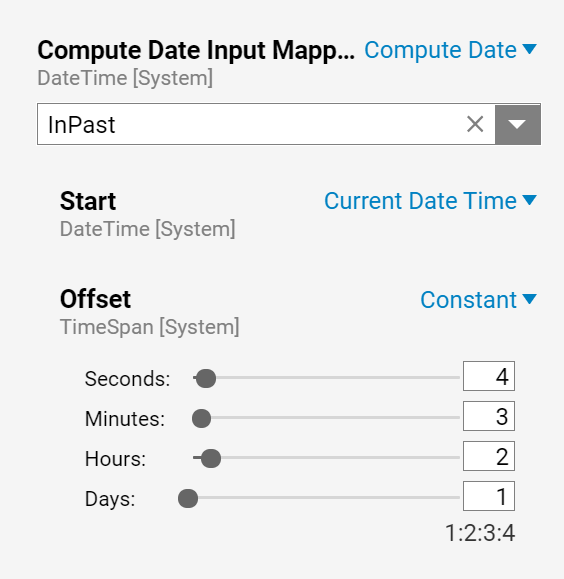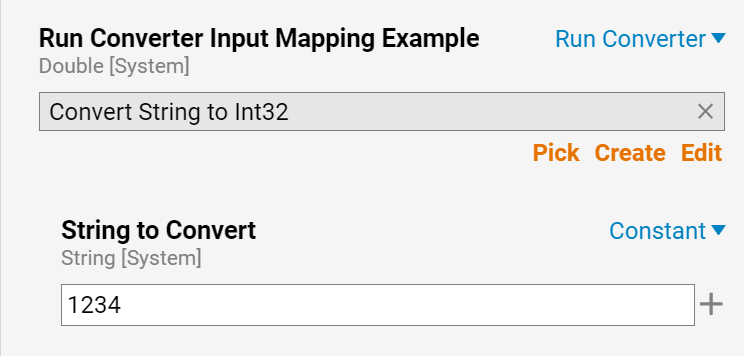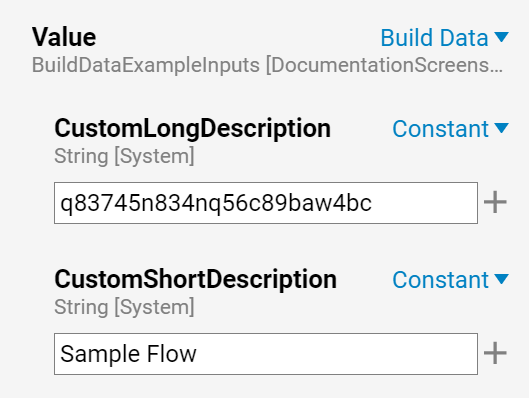Overview
One of the primary reasons to create a custom step is to be able to set up the initial state of an element. This often means setting up the correct types of mappings.
Custom codes are located at C:\Program Files\Decisions\Decisions Services Manager\Instances\Control\CustomReferences
Example
This example will demonstrate how to set up default mappings and describe the different types of input mappings that can be set.
After creating a step, decorate the class to inherit and implement IDefaultInputMappingStep. The implementation of this interface returns an array of IInputMapping. An IInputMapping describes the type of input being set and the value for this input. Below are the various types of input mappings and code examples of how to build them.
ConstantInputMapping
- Corresponding Designer Mapping Type: Constant
- Description: This mapping type allows specifying a constant value for input data.
- Example Code:
new ConstantInputMapping() { InputDataName = "ConstantInputMapping Example", Value = 10} - How the code will be displayed in the Designer:

IgnoreInputMapping
- Corresponding Designer Mapping type: Ignore
- Explanation: This mapping type does not send in anything for the selected input.
- Example Code:
new IgnoreInputMapping() { InputDataName = "IgnoreInputMapping Example" } - What this code looks like in the Designer:

NullInputMapping
- Corresponding Designer Mapping type: Null
- Explanation: This mapping type explicitly sets the value of the input to null.
- Example Code:
new NullInputMapping() { InputDataName = "NullInputMapping Example" } - What this code looks like in the Designer :

SelectValueInputMapping
- Corresponding Designer Mapping type: Select From Flow
- Explanation: This mapping type allows a user to select a variable from within the Flow or Rule to use as input data. The key to setting this in code is to know the DataPath of desired variable (see example code below for how to form a DataPath string).
- Example Code:
new SelectValueInputMapping() { InputDataName = "SelectValueInputMapping Example", DataPath = "Flow Data.CurrentUserEmail" } - What this code looks like in the Designer:

MergeStringInputMapping
- Corresponding Designer Mapping type: Merge Plain Text or Merge HTML Text
- Explanation: This mapping type allows a user to merge strings as plain text or as HTML. To select between plain or HTML merges set the value of MergeResutlType accordingly. The value of this is an enum of DecisionsFramework.Utilities.Data.MergeDataType which can be either Plain Text or HTML.
- Example Code:
new MergeStringInputMapping() { InputDataName = "MergeStringInputMapping Example", MergeResultType = DecisionsFramework.Utilities.Data.MergeDataType.PlainText, MergeString = "My String" } - What this code looks like in the Designer:

CurrentDateInputMapping
- Corresponding Designer Mapping type: Current Date Time
- Explanation: This mapping type sets the value to the current date/time at runtime.
- Example Code:
new CurrentDateInputMapping() { InputDataName = "CurrentDateInputMapping Example" } - What this code looks like in the Designer:

DateInputMapping
- Corresponding Designer Mapping type: Constant Date
- Explanation: This mapping type allows a user to choose a constant date as the input value.
- Example Code:
new DateInputMapping() { InputDataName = "DateInputMapping Example", Value = new DateTime(2020, 11, 05) } - What this code looks like in the Designer:

DateTimeInputMapping
- Corresponding Designer Mapping type: Constant Date and Time
- Explanation: This mapping type is very similar to the DateInputMapping type, but in addition to allowing a user to set a constant date it also allows for time input
- Example Code:
new DateTimeInputMapping() { InputDataName = "DateTimeInputMapping Example", Value = new DateTime(2020, 11, 05, 10, 10, 00) } - What this code looks like in the Designer:

ComputeDateInputMapping
- Corresponding Designer Mapping type: Compute Date
- Explanation: This is a complex mapping type that allows a user to calculate a date based on another date. In the example below, OffsetMapping is set to ConstantInputMapping and DateTimeMapping is set to CurrentDateInputMapping. But both of these could be set to any mapping type that is a value for single date inputs.
- Example Code:
new ComputeDateInputMapping() {InputDataName = "ComputeDateInputMapping Example",ComputeType = ComputeDateType.InPast,OffsetMapping = new ConstantInputMapping() { InputDataName = "Offset", Value = new TimeSpan(1, 2, 3, 4) },DateTimeMapping = new CurrentDateInputMapping() { InputDataName = "Start" }
}
- What this code looks like in the Designer:

RunConverterInputMapping
- Corresponding Designer Mapping type: Run Converter
- Explanation: This is a complex mapping type that allows a user to choose a Flow to convert the value of a variable and then use the converted value as input. The key to setting up this input type is to know the FlowId of the desired converter Flow and to know the names of the input data that the Flow takes in. In the code example below, the ConverterFlowId value is set to the Id of a converter Flow that is delivered with every installation of Decisions, the Convert String to Int32 Flow. Also in the example below, ConverterFlowMappings is built using ConstantInputMapping, but any mapping type that is valid for the data type of the input data will work. (e.g. if the input data was a date, use a DateInputMapping input type.)
- Example Code:
new RunConverterInputMapping() { InputDataName = "RunConverterInputMapping Example", ConverterFlowId = "8a3a318d-bdd6-4a2f-8c4c-ede0ba73deb6",ConverterFlowMappings = new IInputMapping[] { new ConstantInputMapping() { InputDataName = "String to Convert", Value = "1234" } }
- What this code looks like in the Designer:

BuildDataInputMapping
- Corresponding Designer Mapping type: Build Data
- Explanation: This mapping type allows a user to choose a separate mapping type for each field of a data type.
- Example Code:
new BuildDataInputMapping() { InputDataName = "Value", SubMappings = new IInputMapping[] { new ConstantInputMapping() { InputDataName = "CustomLongDescription", Value = "q83745n834nq56c89baw4bc" },
new ConstantInputMapping() { InputDataName = "CustomShortDescription", Value = "Sample Flow" }
}
- What this code looks like in the Designer:

ArrayInputMapping
- Corresponding Designer Mapping type: Build Array
- Explanation: This mapping type allows a user to set the mapping type/value for each item in an array. Each item can have a different mapping type.
- Example Code:
new ArrayInputMapping() { InputDataName = "ArrayInputMapping Example", SubMappings = new IInputMapping[] {
new ConstantInputMapping() { InputDataName = "Item 0", Value = "String 1" },
new ConstantInputMapping() { InputDataName = "Item 1", Value = "String 2" } }
- What this code looks like in the Designer:

ConcatArraysInputMapping
- Corresponding Designer Mapping type: Join Arrays
- Explanation: This mapping type allows a user to join two or more arrays into one as the input. The individual arrays can be built using any mapping type that is valid for an array.
- Example Code:
new ConcatArraysInputMapping() { InputDataName = "ConcatArraysInputMapping Example", SubMappings = new IInputMapping[] { new ConstantInputMapping { InputDataName = "Item 0", Value = new string[] { "String 1", "String 2" } },
new ConstantInputMapping { InputDataName = "Item 1", Value = new string[] { "String 3", "String 4" } }
}
- What this code looks like in the Designer:

ExposeInputMapping
- Corresponding Designer Mapping type: Expose Input
- Explanation: This mapping type is a special version of the SelectValue input type. When used, it automatically creates a piece of input data in the Flow named as the value specified in ExposeAsName and then selects that input data as its value. The exact same thing could be accomplished by manually adding the input data to the Flow and using Select Value to select that input data as the value.
- Example Code:
new ExposeInputMapping() { InputDataName = "ExposeInputMapping Example", ExposeAsName = "ExposeInputMapping Input Data" } - What this code looks like in the Designer:
